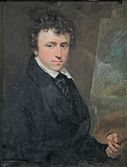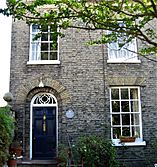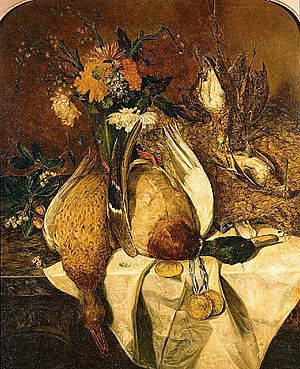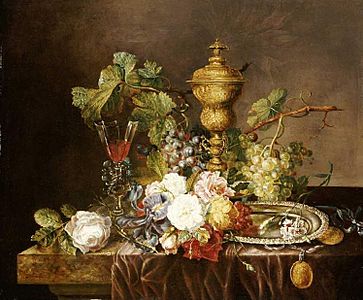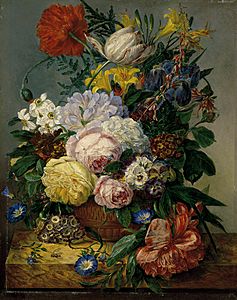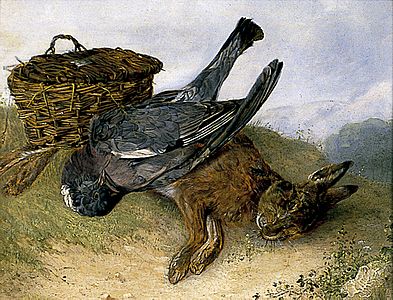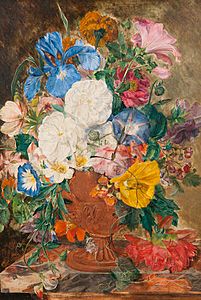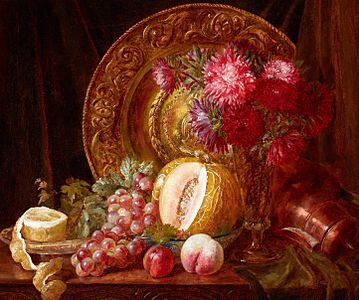Emily Stannard facts for kids
Quick facts for kids
Emily Stannard
|
|
|---|---|
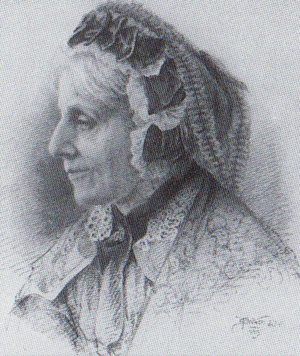
Portrait of Mrs Joseph Stannard (1830–1885) drawn c.1885 by Julian Cedric Brewer
|
|
| Born | 8 February 1802 Norwich, England
|
| Died | 6 January 1885 (aged 82) Norwich, England
|
| Nationality | British |
| Known for | still life painting |
| Movement | Norwich School of painters |
| Spouse(s) | Joseph Stannard |
Emily Stannard (born Emily Coppin; 8 February 1802 – 6 January 1885) was a talented British artist. She was known for her beautiful still life paintings. A still life painting shows objects that don't move, like flowers, fruit, or everyday items.
Emily Stannard was part of the Norwich School of painters. This was a group of artists from Norwich, England, and it was Britain's first art movement outside of London. Many people consider Emily Stannard and her niece, Eloise Harriet Stannard, to be the best British female still life artists of the 1800s.
Emily was born in Norwich to parents who also loved art. In 1820, she traveled to the Netherlands with her father. There, she studied the works of famous Dutch masters like Jan van Huysum. This trip greatly influenced her own painting style.
In 1826, she married Joseph Stannard, who was also an artist from Norwich. Sadly, she became a widow just four years later. Emily continued to paint for many years, even into her eighties. She mostly painted flowers in vases, bowls of fruit, or game animals. Her art was shown in Norwich and London. She won several gold medals for her paintings, starting in 1820. In 1831, she became an honorary member of the Norwich Society of Artists. During her lifetime, local newspapers praised her work. Today, art experts still admire her detailed paintings and her use of color.
The largest collection of Emily Stannard's paintings is kept at the Norfolk Museums Collections, located at Norwich Castle. Her art has been featured in several exhibitions, including Visible Women at Norwich Castle in 2018 and 2019.
Contents
What Was the Norwich School of Painters?
Emily Stannard is connected to the Norwich School of painters. This group was very special in the history of British art in the 1800s. Norwich was the first city in England, outside of London, to have its own group of artists.
Important members included John Crome and John Sell Cotman. Other artists like Joseph Stannard, James Stark, and George Vincent were also part of this group. These artists were linked because they lived in Norwich. They often painted scenes of Norwich and the countryside of Norfolk. They also had close friendships and worked together.
The Norwich Society of Artists started in 1803. Emily Stannard's family showed their art at the Society's exhibitions. Emily herself became an honorary member in 1831. She was the only person in her family to have a formal connection with the Society.
Emily Stannard's Early Life and Family
Emily Coppin was born on 8 February 1802 in Norwich. Her parents, Daniel Coppin and Elizabeth Clyatt, were both amateur artists. Daniel Coppin collected art and helped start the Norwich Society of Artists. Elizabeth Coppin was skilled at copying paintings and won medals for her work.
We don't know much about Emily's early childhood or schooling. In 1820, she traveled with her father to Holland. This trip was very important for her art. She was allowed to copy paintings by the Dutch Master Jan van Huysum in Amsterdam. People praised her copies for being very accurate.
Emily met Joseph Stannard at meetings of the Norwich Society of Artists in 1820. They were both artists. On 3 January 1826, they got married in Norwich. Emily was already a well-known artist by then. They were a good match, both coming from artistic families.
Their daughter, also named Emily, was born in 1827. Their second child, Harriet Augusta, sadly died in March 1830 when she was nine months old. Joseph Stannard died of a lung illness later that same year, at only thirty-three years old. Emily tried hard to find doctors and treatments to save him. She lived for over fifty years after he passed away.
Their daughter Emily also became a still life painter and a teacher. Emily Stannard's niece, Eloise Harriet Stannard, and Eloise's younger brother, Alfred George Stannard, became notable artists too. Joseph's brother, Alfred Stannard, was also an artist. Emily Stannard worked as an artist and teacher in Norwich for over 50 years. Her paintings always received good reviews in the newspapers.
Emily Stannard had a studio in Rose Lane in the city. In her later years, she lived at 12 Cathedral Street with her unmarried daughter, Emily. She passed away there on 6 January 1885.
Emily Stannard's Artistic Journey
Emily Stannard's early paintings showed the influence of the Dutch masters. The way she painted vases and the detailed look of her flowers were very similar to Huysum's style. Sometimes, her unsigned paintings were even thought to be by 18th-century Dutch artists. Her painting Still life: Dead Ducks and a Hare with a Basket and Sprig of Holly shows she was inspired by Jan Weenix. She likely saw his work Dead Hare and Partridges at an exhibition. She may also have seen Dutch master paintings in large country houses in Norfolk. Emily Stannard, with help from her daughter, had a long career teaching art.
Emily Stannard continued her art career until shortly before she died. She painted bouquets of flowers in vases and other traditional still life scenes. These included tableware, fruit, or game animals, usually against a plain background. She first showed her art in 1816. In 1821, at age 17, she won a gold medal from the Norwich Society of Artists for a flower painting. By 1824, she was recognized as a leading still life artist.
She won a second medal in 1822 for a still life of fruit. In 1828, she won a third medal for a painting of game animals. This painting was called Dead Game from Nature. She showed 22 paintings at the Norwich Society of Artists between 1816 and 1825. Her art was also displayed at other exhibitions in Norwich. From 1823 to 1825, she also showed her paintings in London at the Royal Society of British Artists and the British Institution.
Emily Stannard sometimes signed her paintings 'Emily Stannard'. However, she more often signed them 'Mrs. Joseph Stannard'. Her paintings were often left unvarnished. She consistently used thin, diluted paint, similar to the Dutch masters she studied.
How Emily Stannard Was Recognized
Emily Stannard received great reviews from local newspapers throughout her career. In 1823, the Norwich Mercury newspaper wrote that she was "an honour to art" and "an honour to her sex." They praised her taste, hard work, and knowledge shown in her beautiful and detailed pictures.
Her obituary, published after her death, said she had "great artistic merit." It described her as a "very clever painter of fruit, flowers, fish, game, and still life." The article also mentioned her "kindly, gentle, modest, and simple nature."
Today, Emily Stannard and her niece Eloise Harriet Stannard are seen as two of the most skilled British women still life painters of the 1800s. Art historian Josephine Walpole said that Emily's flower paintings show "natural talent" and a "perfect sense of color." Another historian, Derek Clifford, thought she deserved more fame.
The Norfolk Museums Collections is the only public art collection in the United Kingdom that owns Emily Stannard's works. Some of her paintings there include: Still life: hamper with dead wood pigeon and leveret; Still life: dead ducks and a hare with a basket and a sprig of holly (1853); Still life with dead game and a flagon and a string of onions (1847); Dead game and a gun (1835); Dead game (1837); Flowers; Still life: group of dead game birds; and Wild duck (study).
Emily Stannard's art was shown at the Norwich Castle Museum Stannard Exhibition in 1934. She was also featured in the Visible Women exhibition at Norwich Castle in 2018 and 2019.
Gallery


